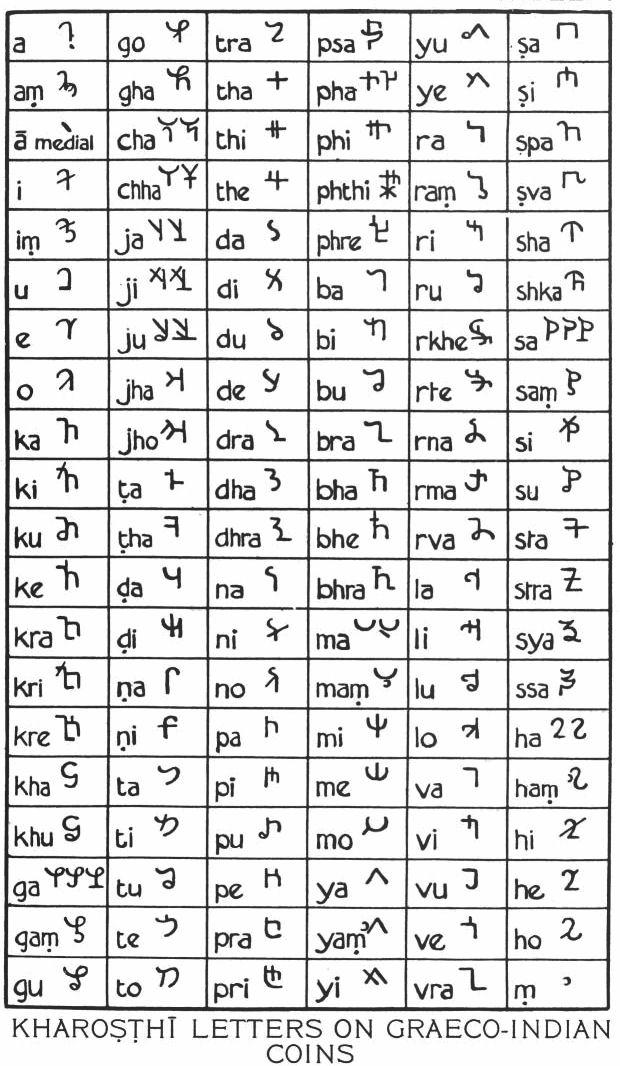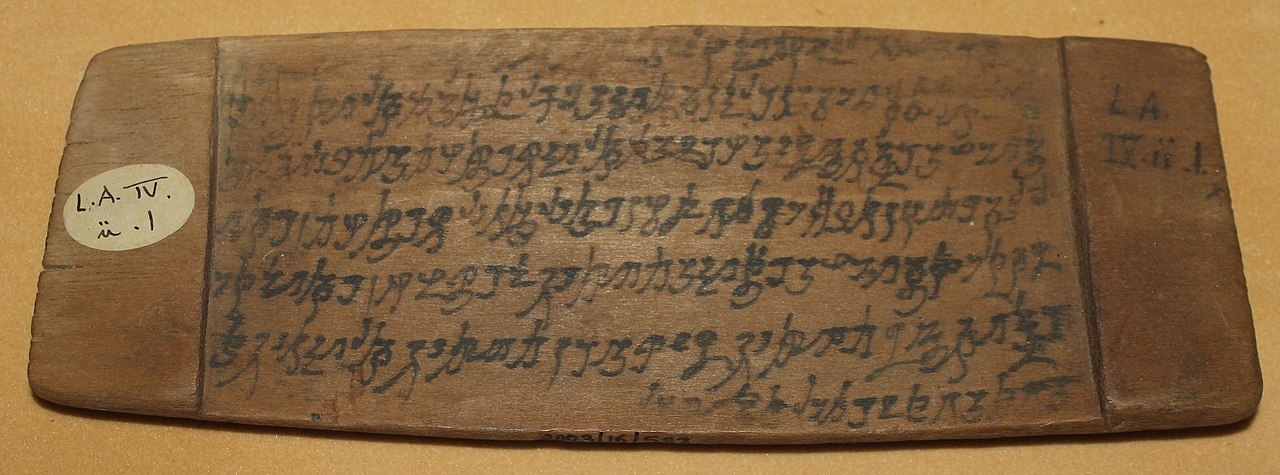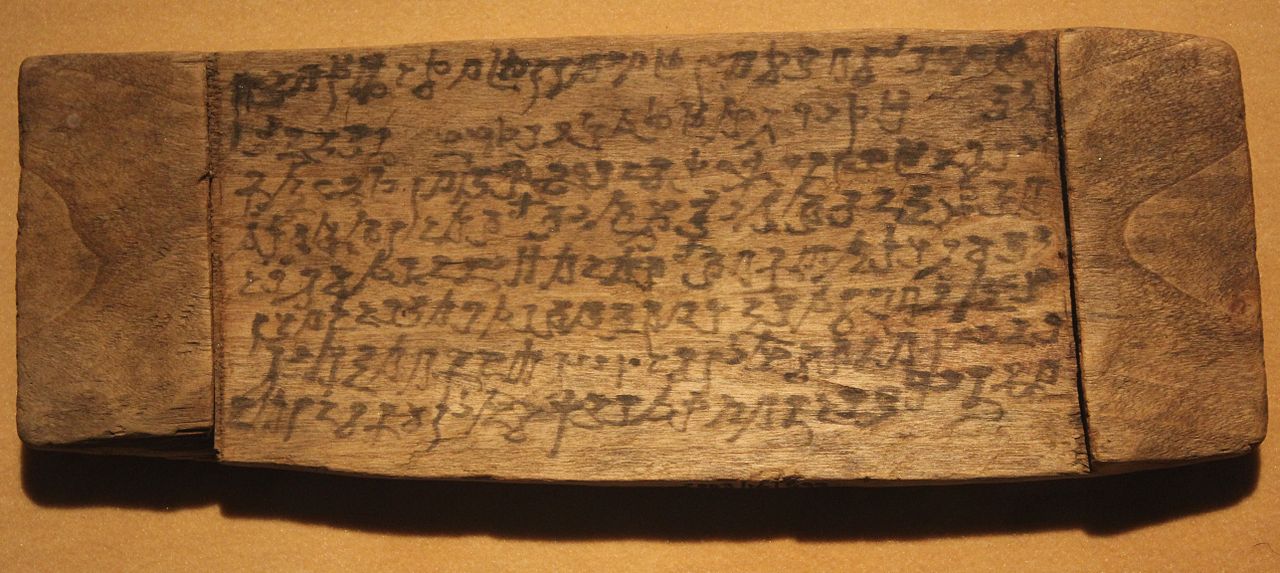Kharosthi, czyli Haroszti – pismo na korze brzozowej
Od Furio Muerte, który napisał: „Jak mają ich na korze spisane teksty z epoki, to watykańskie muzeum per analogiam może mieć nasze.”

Fragmentary Kharosthi Buddhist text on birchbark (Part of a group of early manuscripts from Gandhara), first half of 1st century CE. Collection of the British Library in London
Fragmentaryczny tekst buddyjski Kharosthi na korze brzozowej (część grupy wczesnych rękopisów z Gandhary), pierwsza połowa I wieku n.e. Zbiory Biblioteki Brytyjskiej w Londynie
CB – Tarymowie, Kuszanie, Gąd-Har-Wądowie, Sagu-Dacy (Soko-Dawanie) – to ludy z dużym udziałem haplogrupy R1a – od najdawniejszej starożytności. Długo, długo to trwało nim odnaleziono posimo zachowane na brzozowej korze. Ale oto i ono, co tylko potwierdza, że tego typu odkrycia są możliwe nadal jeśli chodzi o zachodni odłam tychże kultur, które znad Wisły i Dniestru wyrosły. Czy coś wam to pismo przypomina? CB
A oto oficjalna, wikipedyczna polska i anglojęzyczna wersja na temat tego pisma:
Kharoszthi (Kharoṣṭhī), pismo gāndhārī – alfabet sylabiczny używany od III w. p.n.e. do III w. n.e. na terenie starożytnych krain Gandhary, Sogdiany i Kuszanu. Wywodził się z alfabetu aramejskiego. Zachował się w odległych miejscowościach położonych na szlaku jedwabnym aż do VII w. Służył do zapisywania buddyjskich tekstów m.in. w sanskrycie i pali. Został odcyfrowany przez James Prinsepa (1799–1840), który wykorzystał dwujęzyczne monety z alfabetem greckim z jednej strony i tekstem w języku pali w alfabecie kharoszthi na rewersie.
Bibliografia
- Falk, Harry. Schrift im alten Indien: Ein Forschungsbericht mit Anmerkungen, Gunter Narr Verlag, 1993
- Fussman’s, Gérard. Les premiers systèmes d’écriture en Inde, in Annuaire du Collège de France 1988-1989
- Hinüber, Oscar von. Der Beginn der Schrift und frühe Schriftlichkeit in Indien, Franz Steiner Verlag, 1990
- Norman, Kenneth R. The Development of Writing in India and its Effect upon the Pâli Canon, in Wiener Zeitschrift für die Kunde Südasiens (36), 1993
- Salomon, Richard. New evidence for a Ganghari origin of the arapacana syllabary. Journal of the American Oriental Society. Apr-Jun 1990, Vol.110 (2), str. 255-273.
- Salomon, Richard. An additional note on arapacana. Journal of the American Oriental Society. 1993, Vol.113 (2), str. 275-6.
Linki zewnętrzne
Po polsku to już wszystko – oczywiście całkowite ubóstwo umysłowe i brak świadomości jakichkolwiek związków kulturowych słowiano-aryjskich, czy ciągłości Słowian od starożytności do dzisiaj!!!

Kawałek papieru z tekstem w kharoszthi, Basen Tarymu, muzeum prowincjonalne Xinjiangu
anglojęzyczna wiki:
The Kharosthi script, also spelled Kharoshthi or Kharoṣṭhī (Kharosthi: 𐨑𐨪𐨆𐨯𐨠𐨁)[1] was an ancient Indian script used by the Khasa, Saka, and Yuezhi peoples, in present-day northern Pakistan and eastern Afghanistan. It was used in Central Asia as well.[2] An abugida, it was introduced at least by the middle of the 3rd century BCE, possibly during the 4th century BCE,[3] and remained in use until it died out in its homeland around the 3rd century CE.[2]
It was also in use in Bactria, the Kushan Empire, Sogdia, and along the Silk Road. There is some evidence it may have survived until the 7th century in Khotan and Niya, both cities in East Turkestan.
Kharosthi (𐨑𐨪𐨆𐨮𐨿𐨛𐨁𐨌, from right to left Kha-ro-ṣṭhī) is mostly written right to left (type A),
Each syllable includes the short /a/ sound by default[citation needed], with other vowels being indicated by diacritic marks. Recent epigraphic evidence[citation needed] has shown that the order of letters in the Kharosthi script follows what has become known as the Arapacana alphabet. As preserved in Sanskrit documents, the alphabet runs:[citation needed]
- a ra pa ca na la da ba ḍa ṣa va ta ya ṣṭa ka sa ma ga stha ja śva dha śa kha kṣa sta jñā rtha (or ha) bha cha sma hva tsa gha ṭha ṇa pha ska ysa śca ṭa ḍha
Some variations in both the number and order of syllables occur in extant texts.[citation needed]
Kharosthi includes only one standalone vowel which is used for initial vowels in words.[citation needed] Other initial vowels use the a character modified by diacritics. Using epigraphic evidence, Salomon has established that the vowel order is /a e i o u/, akin to Semitic scripts, rather than the usual vowel order for Indic scripts /a i u e o/. Also, there is no differentiation between long and short vowels in Kharosthi. Both are marked using the same vowel markers.
The alphabet was used in Gandharan Buddhism as a mnemonic for remembering a series of verses on the nature of phenomena. In Tantric Buddhism, the list was incorporated into ritual practices and later became enshrined in mantras.

Alfabet Haroszti
Scholars are not in agreement as to whether the Kharosthi script evolved gradually, or was the deliberate work of a single inventor. An analysis of the script forms shows a clear dependency on the Aramaic alphabet but with extensive modifications.
Kharosthi seems to be derived from a form of Aramaic used in administrative work during the reign of Darius the Great, rather than the monumental cuneiform used for public inscriptions.[9] The name Kharosthi may derive from the Hebrew kharosheth, a Semitic word for writing,[9] or from Old Iranian *xšaθra-pištra, which means „royal writing”.[10]
One model is that the Aramaic script arrived with the Achaemenid conquest of the Indus Valley in 500 BCE and evolved over the next 200+ years to reach its final form by the 3rd century BCE where it appears in some of the Edicts of Ashoka. However, no intermediate forms have yet been found to confirm this evolutionary model, and rock and coin inscriptions from the 3rd century BCE onward show a unified and standard form. An inscription in Aramaic dating back to the 4th century BCE was found in Sirkap, testifying to the presence of the Aramaic script in present-day Pakistan. According to Sir John Marshall, this seems to confirm that Kharoshthi was later developed from Aramaic.[11]
The study of the Kharosthi script was recently invigorated by the discovery of the Gandhāran Buddhist texts, a set of birch bark manuscripts written in Kharosthi, discovered near the Afghan city of Hadda just west of the Khyber Pass in Pakistan. The manuscripts were donated to the British Library in 1994. The entire set of British Library manuscripts are dated to the 1st century CE, although other collections from different institutions contain Kharosthi manuscripts from 1st century BCE to 3rd century CE,[12][13] making them the oldest Buddhist manuscripts yet discovered.
While the derived Brahmi scripts remained in use for centuries, Kharosthi seems to have been abandoned after the 2nd-3rd Century AD. Because of the substantial differences between the Semitic-derived Kharosthi script and its successors, knowledge of Kharosthi may have declined rapidly once the script was supplanted by Brahmi-derived scripts, until its re-discovery by Western scholars in the 19th Century.[9]
The Kharosthi script was deciphered separately almost concomitantly by James Prinsep (in 1835, published in the Journal of the Asiatic society of Bengal, India)[14] and by Carl Ludwig Grotefend (in 1836, published in Blatter fur Munzkunde, Germany),[15] with Grotenfend „evidently not aware” of Prinsep’s article, followed by Christian Lassen (1838).[16] They all used the bilingual coins of the Indo-Greek Kingdom (obverse in Greek, reverse in Pali, using the Kharosthi script). This in turn led to the reading of the Edicts of Ashoka, some of which were written in the Kharosthi script (the Major Rock Edicts at Mansehra and Shahbazgarhi).[9]
więcej tutaj: https://en.wikipedia.org/wiki/Kharosthi?fbclid=IwAR27913A0OKViJcfAR2AT2srrYtCY_QqZKvlkHdDbgi11Dw9Hf5DkZa_Sp8

Wooden Kharosthi document found at Loulan, China by Aurel Stein
Dokument na drzewnej korze w języku Kharosthi znaleziony w Loulan w Chinach przez Aurela Steina

Kharoshti script on a wooden plate in the National Museum of India in New Delhi

Kharoshti script on a wooden plate in the National Museum of India in New Delhi

Kharoshti script on a wooden plate in the National Museum of India in New Delhi

haroshti script on wood from Niya, 3rd century CE

Double-wedged wooden tablet in Gandhari written in Kharosthi script, 2nd to 4th century CE
